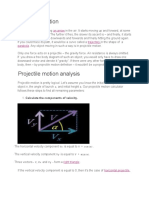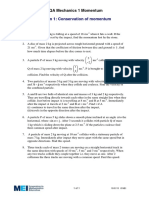0 ratings0% found this document useful (0 votes)
130 viewsProjectile Motion CP
This document provides an overview of projectile motion, emphasizing that students must understand constant acceleration equations and vectors, that gravity is the only force acting on a projectile, the horizontal velocity remains constant, and that the landing level may differ from the starting level.
Uploaded by
wolfretonmathsCopyright
© © All Rights Reserved
Available Formats
Download as PDF, TXT or read online on Scribd
0 ratings0% found this document useful (0 votes)
130 viewsProjectile Motion CP
This document provides an overview of projectile motion, emphasizing that students must understand constant acceleration equations and vectors, that gravity is the only force acting on a projectile, the horizontal velocity remains constant, and that the landing level may differ from the starting level.
Uploaded by
wolfretonmathsCopyright
© © All Rights Reserved
Available Formats
Download as PDF, TXT or read online on Scribd
You are on page 1/ 1
AQA Mechanics 1 Projectiles
Section 1: Projectile motion
Crucial points
1. Make sure that you are fluent with the constant acceleration
equations
The work from chapter 2 must be thoroughly understood before you
tackle this section.
2. Make sure that you are confident with the use of vectors
The work from on kinematics in two dimensions underpins the work in
this unit.
3. Remember that the only force acting on a projectile is gravity
It is common for students to believe that there is some kind on force
acting on the projectile to make it move. This is incorrect.
A projectile must have an initial velocity, and a force will have been
required to give it this initial velocity for example, if you throw a ball, a
force from your arm accelerates the ball to its initial velocity. However,
as soon as the ball has left your hand, i.e. as soon as it becomes a
projectile, the force from your arm ceases to act upon it and the only
force it is subjected to (ignoring air resistance) is the gravity force,
which gives a constant acceleration of g, vertically downwards.
4. Remember that the horizontal velocity of a projectile does not
change
This is linked to 3, above. Remember Newtons first law because
there is no horizontal force acting on a projectile, only a vertical force
due to gravity, the horizontal velocity of a projectile must remain
constant throughout its flight.
5. Dont assume that a projectile always lands on the same level it
started from
When finding the position that a projectile lands, or its time of flight,
always check to see what the vertical displacement is relative to its
starting point.
A common mistake is to assume that it starts and finishes on the same
level, so that its path is symmetrical, meaning its time of flight is twice
the time to maximum height and its range is twice the horizontal
displacement at maximum height. It saves time to find range and time
of flight in this way if the projectile does land at the same level as it
starts, but make sure you check it does or you will get the wrong
answer!
1 of 1
10/01/13 MEI
You might also like
- Using Parametric Equations - Solutions PDFNo ratings yetUsing Parametric Equations - Solutions PDF4 pages
- Grade 12 Physical Sciences Mechanics - CompressNo ratings yetGrade 12 Physical Sciences Mechanics - Compress15 pages
- Part 1 Projectile Motion_20250219_090403_0000No ratings yetPart 1 Projectile Motion_20250219_090403_000055 pages
- 2022+Projectile+Motion+2022+Edited Converted Converted CompressedNo ratings yet2022+Projectile+Motion+2022+Edited Converted Converted Compressed89 pages
- Teaching Topics: Projectiles in M1: - Gun Shot, Canons, FireworksNo ratings yetTeaching Topics: Projectiles in M1: - Gun Shot, Canons, Fireworks5 pages
- Module-8: Motion in Two and Three Dimension: Case 1: Horizontlal ProjectionNo ratings yetModule-8: Motion in Two and Three Dimension: Case 1: Horizontlal Projection7 pages
- Experiment 2 - Free Fall and Projectile Motion: ObjectivesNo ratings yetExperiment 2 - Free Fall and Projectile Motion: Objectives10 pages
- 4. Motion in Two Dimension [Chapter - 4]No ratings yet4. Motion in Two Dimension [Chapter - 4]21 pages
- GQA - Science 9 - Q4 - Wk1 2 - PROJECTILE MOTION CQA GQA - LRQANo ratings yetGQA - Science 9 - Q4 - Wk1 2 - PROJECTILE MOTION CQA GQA - LRQA18 pages
- Projectile Motion, General Solution: Projectile Motion Curved Motion Physics Contents Index HomeNo ratings yetProjectile Motion, General Solution: Projectile Motion Curved Motion Physics Contents Index Home9 pages
- Physics Project Report On Projectile MotionNo ratings yetPhysics Project Report On Projectile Motion18 pages
- Concept Notes With Formative Activities: LAS For Summative AssessmentNo ratings yetConcept Notes With Formative Activities: LAS For Summative Assessment9 pages
- Science9 - Q4 - W1 - Projectile-Motion - Carlos-E.-Del-Rosario-Jr.-EDITED-May-1-2021No ratings yetScience9 - Q4 - W1 - Projectile-Motion - Carlos-E.-Del-Rosario-Jr.-EDITED-May-1-202115 pages
- Aerodynamics for the Commercial Pilot: Aviation Books Series, #10From EverandAerodynamics for the Commercial Pilot: Aviation Books Series, #10No ratings yet
- Using Partial Fractions in Integration Exercise PDFNo ratings yetUsing Partial Fractions in Integration Exercise PDF1 page
- Vectors in Two & Three Dimensions Exercise PDFNo ratings yetVectors in Two & Three Dimensions Exercise PDF2 pages


















































































